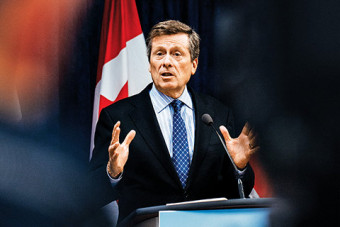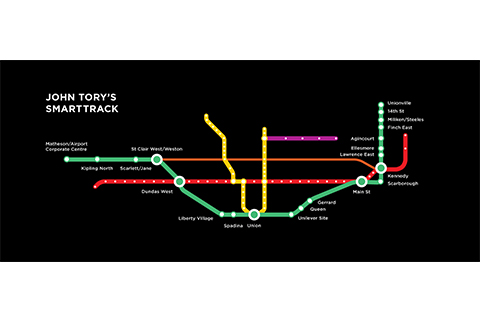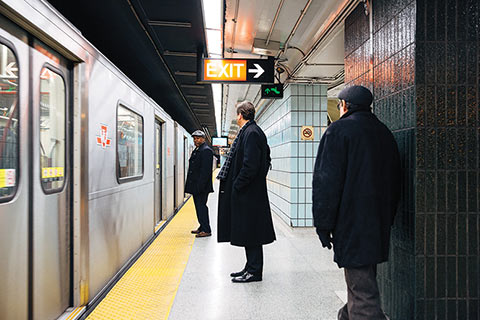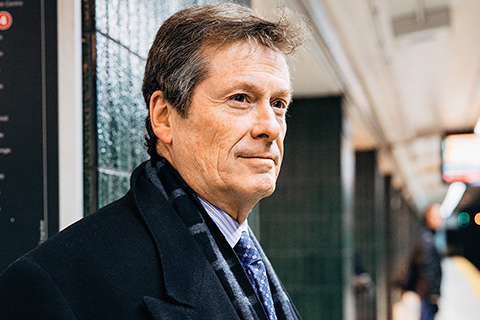On his short morning subway ride to City Hall one bitterly cold day in January, Toronto mayor John Tory found himself chatting with a young woman heading to work. As he often does when approached on such journeys, he asked her about the TTC. The woman told him something about the importance of predictable service that took him aback.
“She said, ‘At our company, you get a fine for every 15 minutes you’re late,’” recounts Tory, who leaves his Bloor Street condo every morning at 6:15. “I said, ‘I’ve been on [corporate] boards, and I’ve never heard of such a thing.’”
He has now.
In his brief tenure as mayor, Tory (BA 1975 Trinity) has listened to all sorts of accounts from people who offer up a polite greeting and a personal story: office cleaners who depend on packed all-night Yonge Street buses to get to job sites by 4:30 a.m., or health-care workers who must navigate several connections en route to University Avenue hospitals in time for the 6 a.m. shift change. The woman he spoke to that January morning had another commuting pressure on the other end of her day: getting home in time to make it to a night school, where she’s studying to be a nutritionist.
Despite his years as a call-in radio show host, such random encounters seem to have struck a nerve. Tory recalls that at one of his first transition meetings, TTC CEO Andy Byford brought in a map showing where transit service had been reduced or eliminated as a result of recent budget cutbacks. “It’s quite a stunning picture,” says Tory. The lines on Byford’s map, combined with those morning stories, have started to “match up,” he adds. “People tell you about how they get to work, and that the service is so bad.”
That encounter occurred just days after Tory launched his first budget, which featured a $95-million boost to the TTC, plus a fare hike. Pundits and critics were quick to note that Tory had helped himself to one of the main planks in Olivia Chow’s mayoral campaign (a pledge to restore bus service) while breaking one of his own (a promise to freeze TTC fares), all in one gesture.
The budget launch came in the midst of a frenzy of mayoral activity that began almost from the moment the former Rogers executive took office. In his first hundred days, Tory launched an aggressive effort to ticket vehicles stopped illegally on downtown streets during rush hour; ordered up a series of key studies for his SmartTrack transit plan; and asked former mayor Art Eggleton to lead a rethink of the city’s affordable housing policy. He even waded into the middle of a tense fight between the local board of education and the provincial government over proposed school closures.

All the while, the chatty 60-year-old lawyer has set to work rebuilding morale in the civil service and turning down the rhetorical temperature after four years of the Ford brothers’ brand of chaotic populism. He releases his schedule to the media, holds frequent press conferences, answers reporters’ questions and makes appearances all over Toronto. Even the blinds to his office overlooking Nathan Phillips Square are left wide open, something that rarely happened in the Ford days.
There’s little doubt that Tory is seeking to position himself as a socially conscious leader who’s careful with the taxpayer’s dollar. With the tell-tale impatience of someone steeped in the ways of the private sector, Tory wants to unclog the municipal machinery and fast-track agreements with other levels of government to bring investment, jobs and more opportunity to low-income communities.
It’s an ambitious program, and Tory admits he’s still trying to determine how to tackle tough issues, such as high levels of youth unemployment. “He resisted the idea of a ‘hundred days’ agenda,” observes John Duffy (BA 1986 Trinity), a long-time Liberal insider who advised Tory on the campaign. The mayor, Duffy says, wanted to figure out council and the tasks ahead of it. “He’s a rookie, and he knows it.”
Tory may be a neophyte in the municipal arena, but he’s hardly a newbie when it comes to politics. One of four siblings, he grew up in a family intimately tied to the Canadian establishment. His great-grandfather helped found Sun Life; his grandfather started the law firm now known as Torys LLP, which his father, John Sr. (who died of a stroke in 2011), and his uncle James later joined. Among their most prominent clients: the late Ken Thomson, who sought their advice as he built his newspaper chain into a global conglomerate.
After graduating from the University of Toronto Schools, Tory studied politics and history at U of T in the early 1970s, soaking up the animated lectures and discussions in small classes offered by such legendary profs as Ken McNaught and Robert Bothwell. In his spare time, Tory hung out in the Buttery at Trinity College playing cards or working at the Top 40 AM station CFTR, where he eventually become a radio reporter. Despite dabbling in journalism, he always had his sights on law and politics.
As a young lawyer, Tory served as principal secretary to former Ontario premier Bill Davis, and later volunteered for Brian Mulroney and Kim Campbell. After the federal Progressive Conservatives’ historic drubbing at the polls in 1993, Tory returned to the private sector, first as CEO of Rogers Media, and then president and CEO of Rogers Cable. Off the clock, he put his name and extensive contact list behind fundraising campaigns for organizations such as St. Michael’s Hospital, the United Way and the Salvation Army.
In the early 2000s, he returned to politics, finishing second to David Miller in Toronto’s 2003 mayoral race. Tory followed that campaign with a successful bid for the leadership of the Ontario PCs, but lost the provincial election in 2007, largely because of a pledge to offer funding to religious schools. He retreated from politics, but kept his name in the public eye with a radio show on CFRB.
***

On a Tuesday morning in January, Tory, city manager Joe Pennachetti and budget chair Gary Crawford take their places at a lectern in a City Hall lounge and launch the 2015 budget process, an annual ritual of jockeying and handwringing that typically produces a spending plan by March.
As the budget press conference begins, Tory offers up some sound bites about the proposal and then talks up his transit investment, including a plan to allow children under 12 to ride for free – “we are doing something to help those who need the help most,” he says. For transit, the budget also includes a $75-million payment to Metrolinx to compensate for the cancellation of the Scarborough LRT in favour of a $3.4-billion Scarborough subway, as well as $2.4 million for studies on SmartTrack, an electric rail service that will run on existing Go Transit tracks from Markham to Union Station and then back up toward Pearson International Airport.
Tory claimed during the mayoral race he’d pay for SmartTrack’s $8-billion price tag using federal and provincial grants, as well as “tax increment financing” (TIF), a revenue tool that allows municipalities to borrow against future tax assessment growth by investing in infrastructure meant to boost property values.
Tory persuaded his executive committee and council to spend $340,000 to retain U of T’s Transportation Research Institute, headed up by Eric Miller, a professor of civil engineering, to conduct a detailed analysis of the SmartTrack proposal and how to integrate it with the rest of the region’s transit network. “For years, I’ve been arguing that the city needs a comprehensive transportation planning study,” says Miller, who came out in support of SmartTrack during the campaign. “We have a chance over the next six months to do a bit of that.”
Almost from the moment the election results were announced, John Tory has given every appearance of a guy in a hurry. Besides the endless cycle of public appearances and press availabilities and council sessions, he’s set in motion numerous studies, task forces and reviews.
Going back to the mid-1980s, Miller’s research group has been conducting transportation surveys in Greater Toronto. The province and regional transit agencies draw on the results, compiled every five years, to plan service levels, but Miller also uses the findings to project rider use of proposed transit lines. “I think SmartTrack will be a good addition to the network,” he says. But, he adds that he’s not jumping to conclusions. “We have to find that out. We need to seriously test SmartTrack – and test it against other ideas.”
Those other ideas, Miller says, will likely include various routes of the proposed Relief Line, a subway plan meant to relieve pressure on the Yonge-Bloor interchange, and a possible eastward extension of the Sheppard subway.
Quite apart from Miller’s analysis, Tory says he’s interested in finding ways for the city to work more closely with its four universities. Earlier in the winter, he met over dinner with the presidents of York, Ryerson and OCAD universities and U of T’s Meric Gertler to talk about issues such as student housing, as well as ways to link research to policy-making and economic development. “We talked a lot about the notion of putting the resources of the university to work for the city – both in terms of advice, but also in terms of jobs and economic development,” says Tory, who feels the city should regard the universities’ students, teachers and researchers as a resource – “partners in innovating.” He mentions how Rotman MBA students have developed case studies on topics such as improving the condition of Toronto Community Housing’s apartment stock. “We never see the output of that,” he muses. “There are probably 25 good ideas coming out of the minds of 25-year-old students who are bright and imaginative and thinking differently than the way we think. But are we smart enough to call down and say, ‘could you send us their answers?’”
Even though the expert evaluations of Tory’s transit plan won’t be completed before fall, the mayor is already hearing plenty of feedback about both the route and the eventual cost of both SmartTrack and the Scarborough subway. Susannah Bunce, a professor in the City Studies program at UTSC, says neither the three-stop subway nor SmartTrack will help the low-income communities in east Scarborough she works with. “I have been disappointed with the conversation about Scarborough transit and the focus on west and central Scarborough,” she notes, adding that dedicated bus lanes and additional stops would do more to help commuters in those areas. “Transit access is a really big issue.”
The financial picture is also fuzzy. Tory said during the election that he’d ask Ottawa to contribute a third of SmartTrack’s cost – about $2.7 billion, a figure that exceeds the total amount of federal infrastructure funding currently allocated to all of Ontario. As for the TIF contributions, Tory’s campaign estimated that the money could be generated by new development along the corridor. Enid Slack, director of U of T’s Institute on Municipal Finance and Governance, points out that TIF has been used successfully in American cities aiming to revitalize derelict areas, but not with a transit project on the scale of SmartTrack. “We have to be careful about what development occurs along those lines,” she observes. “If we overestimate, we’ll be in trouble if the development doesn’t occur.” She adds that the city “has to look for other revenue sources and not rely on just one.”
***

As Toronto’s new mayor strides briskly to a mid-morning meeting with some economic development boosters high atop an office tower on Bay Street, he abruptly veers off the sidewalk and darts into the sluggish traffic downtown.
“You can cross wherever you want,” Tory half shouts over his shoulder, in the direction of a small retinue of handlers. “People have this misguided notion that you actually have to go to the intersection. That’s the safest way to do it. But it’s not against the law unless you’re impeding traffic.”
Almost from the moment the election results were announced, Tory has given every appearance of a guy in a hurry. Besides the endless cycle of public appearances and press availabilities and council sessions, he’s set in motion numerous studies, task forces and reviews. He attends monthly meetings of a high-level committee of city officials assigned to co-ordinate construction and unclog the roads, as well as strategy sessions with other mayors from both the region and across Canada.
And unlike his predecessor, he spends hours – often early in the morning, before the day’s agenda gets ugly – poring over the mind-numbingly detailed reports and budget documents that stream out of City Hall. It’s not just about learning the issues. Drawing on his stint as a Rogers executive, Tory has elected to be a highly visible manager, and he’s taken to cold-calling the staff members whose names appear at the bottom of reports, peppering them with queries.
Such overtures are partially to sate his curiosity about the inner workings of the byzantine bureaucracy he now oversees, and they’re also meant to signal to city staff that the chief magistrate is on the job again. Tory well knows that the recipients will tell their colleagues about such calls. His objective is to use praise and engagement as leverage to get things moving after a period when Ford routinely disparaged the civil service as self-interested, reckless and bloated.
Tory says that by the time he stands for re-election, he will want to show voters that there’s been employment growth and investment throughout the city, including its economically sluggish areas – and especially the more remote regions of Etobicoke, North York and Scarborough. As for Toronto’s stubbornly high youth unemployment rates, another major talking point for Tory during the campaign, the mayor says he’s mulling over a plan, but will likely focus on building mentoring networks. “I want to get a bunch of business leaders in the room and lock the door and say, ‘You can’t go out until you’ve talked to me about how we can better partner up.’”
A critically short supply of affordable housing is another famously intractable issue that Tory has pledged to tackle. “All the bills are going to come due at once,” observes Zack Taylor, a professor in UTSC’s City Studies program, noting that the capital repair backlog for Toronto Community Housing represents a financially crushing pressure by itself. “That is the major problem for the next two terms.” He also notes that Toronto’s housing woes aren’t just about long waiting lists for subsidized apartments. They extend into the private market, where young people hand over huge sums for tiny condos and single family homes become far too expensive for all but the most affluent. “If we become London, where kindergarten teachers and bus drivers have to commute from the back of beyond to work those jobs in the centre, we become an even more spatially divided society.”
Tory’s first move on the housing file was to appoint Art Eggleton to head a six-person task force to figure out how to deal with a range of issues related to affordable accommodation, including the community housing repair backlog, estimated to cost $2.6 billion over the next decade. The group includes former TD Bank chair Ed Clark (BA 1969 UC), who is chair of the advisory committee of U of T’s School of Public Policy and Governance, and long-time Ontario housing official Janet Mason, a U of T professor of public policy. “We need new ideas, new ways to get more done,” says Tory.
With the presidents of the city’s four universities, all of whom are dealing with a student housing crunch, Tory has discussed fast-tracked approvals on new residence buildings, as well as the possibility of using city-owned land as an incentive for developers to build low-cost units.
Other ideas are also surfacing. Mitchell Cohen, president of Daniels Corporation, which is in the midst of a $1-billion redevelopment of Regent Park, says the city could ask the province to implement legislation that would allow a so-called “inclusionary zoning” bylaw, which would require all developers to add a specified proportion of affordable units to new residential buildings. He predicts that developers will grouse, but he says mandatory measures create a level playing field and don’t force builders who want to do the right thing to go out on a limb financially. “If the city said, every builder is subject to this regulatory change, guess what? They’ll do it. And we’ll have a fundamental shift.”
Tory, however, says he’s not ready to back inclusionary zoning, and adds that he’s wary of magic bullets. Presumably, he’s waiting for Eggleton’s task force to come back with recommendations. But that report will take its place on a shelf crowded with earlier attempts to crack Toronto’s worsening housing problems; all of the post-amalgamation mayors, including Ford, have waded into this minefield. Yet apart from the redevelopment of Regent Park, which began about a decade ago, there’s been scant progress, largely because the federal and provincial dollars that once flowed into housing are long gone. “Housing is very expensive,” Mason observes. “Who are you going to take the money from?”

For Tory, it’s not a small question. While he’s promised to reunite the city, the electoral reality, as Zack Taylor points out, is that the city’s wealthiest neighbourhoods supported Tory in the election, while the suburban communities he wants to help overwhelmingly backed the Ford brothers, and their vision of low-cost government.Tory, for his part, has to hope that if he manages to deliver better transit, more jobs and improved housing to those inner suburbs, the residents there will back him in 2018.
When he arrives back to City Hall from his morning off-site meetings, Tory makes a beeline towards the mayor’s suite of second-floor offices. At the base of the stairs, he notices a sign for a Civic Action event – a gathering of the group’s young leaders network – taking place in the council chamber. Pledging only a short detour to his clock-watching handlers, Tory heads to the elevator door immediately opposite the mayor’s office.
Once inside, the lift refuses to start, and Tory realizes he needs to swipe his City Hall-issued ID card. He reaches into his pants pocket and pulls out a fistful of cards and folded papers. “I had it this morning,” Tory mutters, riffling through the wad of stuff. After a few moments, he finds the generic plastic card, which bears his mug shot, his name and that magic word, “Mayor.”
“It reminds me of what I am,” he muses, as the cramped elevator lurches up.
Journalist and author John Lorinc (BSc 1987 UC) writes about politics and urban issues for The Globe and Mail, The Walrus and Spacing magazine. He is the author of The New City: How the Crisis in Canada’s Urban Centres is Reshaping the Nation (2006).
Recent Posts
For Greener Buildings, We Need to Rethink How We Construct Them
To meet its pledge to be carbon neutral by 2050, Canada needs to cut emissions from the construction industry. Architecture prof Kelly Doran has ideas
U of T’s 197th Birthday Quiz
Test your knowledge of all things U of T in honour of the university’s 197th anniversary on March 15!
Are Cold Plunges Good for You?
Research suggests they are, in three ways






One Response to “ Man on the Move ”
Excellent article and reporting.